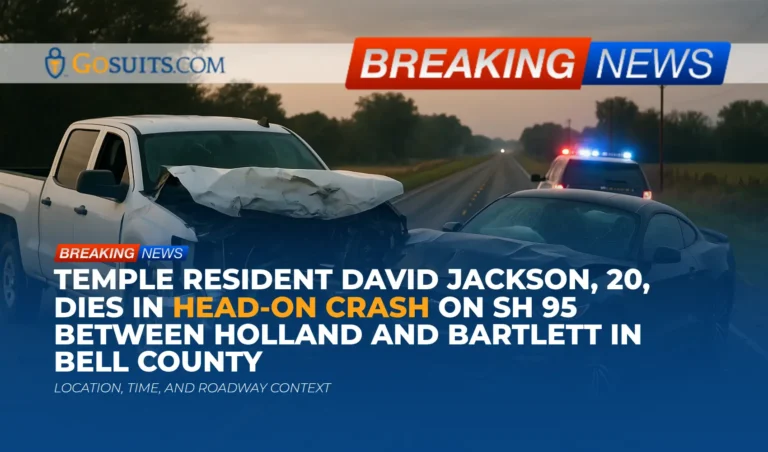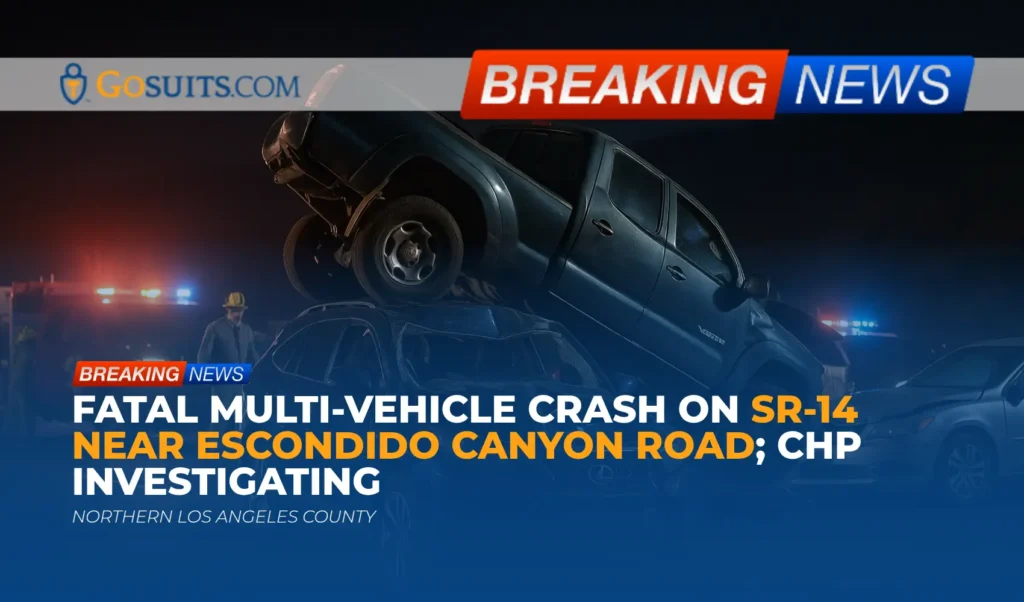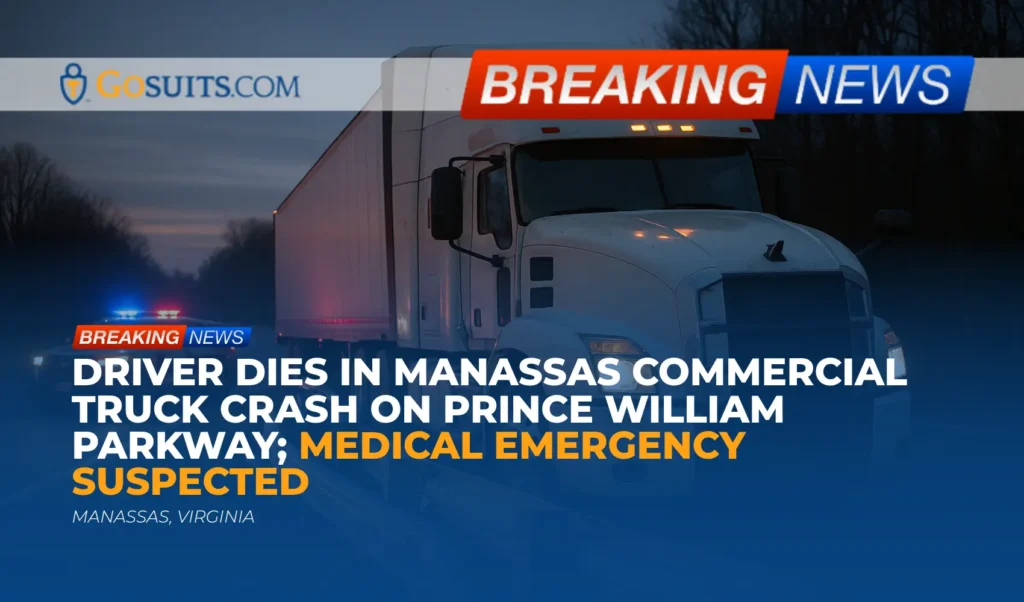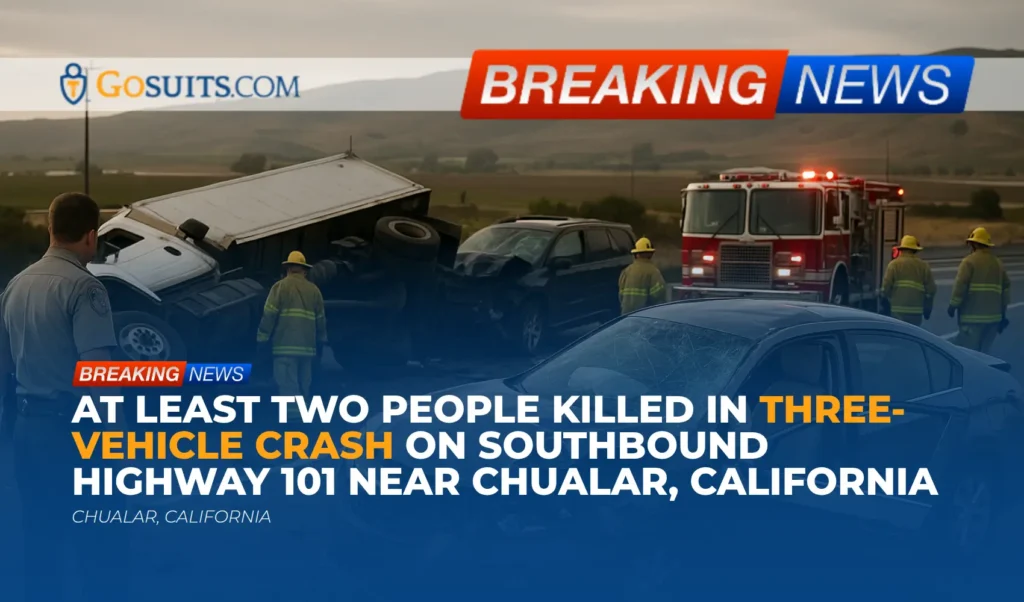- Overview of the Bell County collision
- What investigators have reported so far
- Location, time, and roadway context
- What families can do in the first days
- How to obtain official records
- Texas Peace Officer’s Crash Report
- Law enforcement incident records
- Autopsy and inquest records in Texas
- Death certificates
- Preserving evidence after a fatal crash
- Potential civil liability and insurance considerations in Texas crashes
- Wrongful death and survival claims in Texas
- Common safety factors in head-on and lane departure crashes
- Community and bereavement resources
- Why timely action matters
- Commentary from Gosuits Bell County, Texas Personal Injury Attorney
Overview of the Bell County collision
A two-vehicle collision on State Highway 95 in Bell County, Texas, claimed the life of a 20-year-old Temple resident, David Jackson. The crash occurred in the early morning hours of October 9 on the stretch of SH 95 near Lindemann Road between Holland and Bartlett. According to preliminary information shared with the public, a northbound pickup crossed into the southbound lane and collided with a southbound car. Jackson, who was driving the car, was pronounced deceased at the scene. The pickup’s driver, a 35-year-old man, was transported to a local hospital with non-incapacitating injuries. State authorities are investigating, and additional details have not yet been released.
Our hearts are with the family, friends, and community members mourning this loss. Early reports can feel incomplete and frustrating. The purpose of this article is to clearly outline what is known, explain how investigations typically proceed, and share practical steps families can take to protect their rights and access the records they may need in the coming weeks.
What investigators have reported so far
Based on information made public at this time, the available facts include:
- Date and time October 9, around 4:58 a.m.
- Location State Highway 95 near Lindemann Road, between the communities of Holland and Bartlett in Bell County.
- Vehicles A 2017 Chevrolet pickup traveling northbound and a 2017 Ford Mustang traveling southbound.
- Sequence described The pickup reportedly crossed into the southbound lane and struck the Mustang driven by Mr. Jackson.
- Injuries Mr. Jackson was pronounced deceased at the scene. The pickup driver was transported to Baylor Scott and White with non-incapacitating injuries.
- Status The Texas Department of Public Safety is investigating. The roadway was closed for the investigation and later reopened.
It is common for law enforcement to release only basic information in the first 24 to 72 hours. More detail often becomes available in the official Texas Peace Officer’s Crash Report, diagrams, photographs, measurements, and any supplemental narrative once the investigation progresses.
Location, time, and roadway context
SH 95 in southern Bell County is a rural highway with segments that are undivided two-lane roadways. Early morning darkness, variable lighting, and changing traffic volumes can affect visibility and reaction time. When a vehicle crosses the centerline into oncoming traffic, the risk of a severe head-on impact grows significantly because the closing speeds of both vehicles add together.
Texas law requires drivers to travel on the right half of the roadway except in limited circumstances, and to maintain their lane as practicable. See Texas Transportation Code provisions on driving on the right and laned roadways at: Transportation Code §545.051 and §545.060. These statutes are part of the framework investigators consider when evaluating lane departure collisions.
What families can do in the first days
In the aftermath of a fatal crash, families are often asked to make decisions while still in shock. It is entirely reasonable to take the time needed to gather information and ask questions. Some immediate, practical steps that can help include:
- Identify the lead investigating agency In rural Bell County, that is often the Texas Department of Public Safety Highway Patrol, sometimes with support from local sheriff’s deputies. Confirming the case number and lead trooper or investigator can help with future record requests.
- Preserve documents and communications Save any notifications from law enforcement, medical providers, or insurance companies. Keep emails, voicemails, and texts in a safe place.
- Document what you know Write down times, locations, and names of anyone who contacted you. If you know of potential witnesses or nearby businesses with cameras along SH 95 or Lindemann Road, note their names and addresses.
- Be cautious with insurance communications Insurance adjusters may request recorded statements quickly. What is said can be used later in ways that are not obvious at the time. It is generally wise to speak with a seasoned personal injury attorney before providing statements, signing authorizations, or accepting any payment.
- Plan to obtain official records Crash reports, inquest or autopsy documentation, and the death certificate are often needed for family, administrative, and legal tasks. More on how to request these records appears below.
How to obtain official records
Several official documents exist after a serious crash. Different agencies hold different records. The following resources are provided to help families and representatives understand where to request information in Texas.
Texas Peace Officer’s Crash Report
The Texas Peace Officer’s Crash Report (CR-3) typically becomes available within days to a few weeks, depending on the complexity of the investigation. It includes the officers’ narrative, diagram, contributing factors, roadway and weather conditions, and identifying details for involved parties. In Texas, crash reports are maintained by the Texas Department of Transportation’s Crash Records Information System.
Request information is available from TxDOT at: TxDOT Crash Reports. The TxDOT portal provides guidance on eligibility to obtain a CR-3, payment, and delivery options.
Law enforcement incident records
Beyond the CR-3, additional investigative materials may exist, such as scene photos, measurements, and supplemental narratives. For crashes investigated by the Texas Department of Public Safety, public information requests can be submitted under the Texas Public Information Act.
See DPS guidance at: Texas DPS Public Information Act Requests. Responses may take time and can include redactions while investigations remain open.
Autopsy and inquest records in Texas
Texas law provides that sudden, unexpected, or violent deaths are investigated by a county medical examiner, if one exists, or by a Justice of the Peace through an inquest process. The governing procedures are outlined in the Texas Code of Criminal Procedure, Chapter 49. Depending on county structure and resources, an autopsy may be ordered and conducted at a regional medical examiner’s office.
Legal framework: Tex. Code Crim. Proc. ch. 49. Families can typically request final autopsy or inquest reports from the office that ordered the examination once the report is complete. Availability and format can vary by county and by whether the investigation remains active.

Death certificates
In Texas, certified copies of death certificates are issued by the Texas Department of State Health Services Vital Statistics Section. Funeral homes often assist with initial requests. Eligible relatives can order additional copies as needed.
For instructions and eligibility, visit: Texas DSHS Vital Statistics – Death Records.
Preserving evidence after a fatal crash
Evidence can be lost or degraded quickly. Steps to preserve critical information often include:
- Vehicles and black box data Modern vehicles frequently store event data recorder information such as speed, throttle, and braking just before impact. Preserving both vehicles unaltered until the data can be imaged is important. NHTSA provides an overview of event data recorders at NHTSA Event Data Recorders.
- Scene documentation Skid marks, debris fields, and gouge marks are useful for reconstruction. Photographs and measurements from law enforcement help, but independent documentation can provide additional angles and context.
- Nearby cameras and witnesses Businesses, residences, schools, or traffic-facing cameras along SH 95 or nearby roads may overwrite footage within days. Early outreach can prevent loss of recordings.
- Cell phone records In some investigations, phone data may be examined to see if distraction played a role. Access typically requires legal process. A preservation request sent promptly can be crucial.
- Maintenance and recall records For both vehicles, service histories and any open recalls may be relevant in claims alleging component failure or tire issues.
Families often work with a skilled attorney and independent crash reconstruction professionals to ensure that spoliation is avoided and that evidence is collected systematically and respectfully.
Potential civil liability and insurance considerations in Texas crashes
While every collision is fact specific, a crossover into an oncoming lane raises serious questions about negligence. Under Texas law, drivers must keep to the right half of the roadway and drive only within a single lane as nearly as practical, moving from that lane only when safe. See Transportation Code §545.051 and §545.060. Evidence that a driver crossed the centerline without legal justification is frequently central in determining civil fault.
Insurance companies will assess the facts quickly. It is common for liability insurers to:
- Seek recorded statements Adjusters may ask family members or witnesses to provide statements early. These can be used to shape liability assessments. It is generally prudent to consult an attorney before giving any statement.
- Request broad medical or personal records Some requests go beyond what is necessary to validate a claim. Careful review of any authorization is important.
- Make early settlement offers Initial offers can arrive before the full scope of damages or wrongful death beneficiaries’ rights are understood. Acting too quickly can limit future options.
In fatal collisions, multiple insurance policies may be implicated, including the at-fault driver’s liability coverage and potentially underinsured motorist coverage on the decedent’s household policy. If the pickup involved in this crash was being used for work, employer liability issues may also be explored depending on the facts. Thorough investigation is essential before evaluating coverage and responsibility.
Wrongful death and survival claims in Texas
Texas law recognizes two distinct civil pathways after a death caused by another’s wrongful act, neglect, carelessness, unskillfulness, or default.
- Wrongful death claim This belongs to certain family members for their own losses resulting from the death. Texas Civil Practice and Remedies Code provides that a spouse, child, and parent may bring a wrongful death action. See CPRC §71.002.
- Survival claim This preserves the decedent’s own claim that would have existed if they had lived, passing to the estate. See CPRC §71.021.
Time limits apply. In many Texas wrongful death and survival matters, a two-year limitations period is the default, calculated from the date of the incident. There are exceptions and nuances depending on the facts, parties, and notice requirements. See CPRC §16.003. Because there are important steps that must occur well before any deadline, families often choose to consult counsel promptly for guidance specific to their circumstances.
Common safety factors in head-on and lane departure crashes
Head-on collisions are among the most severe roadway events due to combined speeds and direct impact forces. Typical contributing factors investigated include:
- Lane departure Unexplained crossing of the centerline may relate to inattention, fatigue, impairment, evasive maneuvers, or roadway factors. Vehicle dynamics and scene evidence help reconstruct the sequence.
- Low light conditions Early morning darkness can affect depth perception and detection of lane markings or oncoming vehicles, especially on undivided rural highways.
- Speed and reaction time Even modest increases in speed can shorten reaction windows and extend stopping distances.
- Roadway design Shoulder width, rumble strips, lane markings, and signage can influence crash likelihood and severity. The Federal Highway Administration recognizes centerline rumble strips as a countermeasure that can reduce head-on and opposite-direction crashes on two-lane roads. See FHWA information on centerline rumble strips at FHWA Centerline Rumble Strips.
While safety infrastructure plays a role, the core of civil liability focuses on the conduct of drivers and the facts of the specific collision.
Community and bereavement resources
Losing a loved one in a sudden crash is devastating. Support from trusted professionals and community resources can help families navigate this period.
- Emotional support and counseling The SAMHSA National Helpline offers free, confidential treatment referral and information, available 24 hours a day at 1-800-662-HELP (4357). More information at SAMHSA National Helpline. For immediate mental health support, information about the 988 Suicide and Crisis Lifeline is at SAMHSA – 988 Lifeline.
- Crime victim services If a crash involves criminal conduct such as intoxication, the Texas Office of the Attorney General provides information about rights, notifications, and potential financial assistance to eligible victims. See Texas OAG Crime Victim Services.
Grief and practical needs can evolve over time. It is understandable to seek help at any stage.

Why timely action matters
Several time-sensitive considerations often follow a serious crash:
- Evidence can disappear quickly Video systems overwrite, tire marks fade with traffic and weather, and vehicles can be moved or repaired. Early preservation efforts can make a measurable difference in what can be proven later.
- Insurance investigations begin immediately Insurers start building their files within hours. Without careful guidance, statements and documents provided early can be misunderstood or taken out of context.
- Multiple deadlines may apply Beyond the general limitations period, there may be notice requirements for certain claims or policies. Meeting these timelines requires organization and prompt action.
- Families benefit from a clear plan A step-by-step approach to records, benefits, and decision-making can ease stress. This often includes obtaining the crash report, securing vehicles for inspection, and coordinating with the inquest authority about release of remains and reports.
- Professional guidance helps balance priorities It is appropriate to prioritize family and memorial arrangements first. At the same time, early consultation with a seasoned attorney can outline options, help avoid missteps with insurers, and coordinate evidence preservation while the family focuses on healing.
If any communication arrives from an insurance company requesting a recorded statement or signature on authorizations, it is generally best practice to seek a free consultation with an attorney before responding. What is communicated to the insurer can be used later in ways that may not be immediately apparent.
Commentary from Gosuits Bell County, Texas Personal Injury Attorney
We extend our deepest sympathies to the family and friends of David Jackson and to the Bell County communities affected by this tragedy. Losing a loved one without warning is unbelievably hard. This article is provided for educational and general informational purposes to help the community understand what typically happens after a serious crash and where to find key records.
From a civil injury perspective, reports that a pickup crossed into the oncoming lane on SH 95 raise immediate concerns about lane discipline and roadway safety. In Texas, drivers are required to keep to the right and maintain their lane except when it is safe to change lanes or pass. When a vehicle departs its lane and enters the path of oncoming traffic, head-on collisions can result in catastrophic outcomes, as appears to have occurred here. A thorough investigation that includes scene analysis, vehicle inspections, and data downloads is critical to determine precisely why the crossover happened and whether preventable factors were involved.
In our experience, insurance carriers and corporate risk teams move fast after a serious crash. They often contact families quickly, request recorded statements, and seek broad releases for medical or personal information. These steps are designed to manage the insurer’s exposure. Without familiarity with the process, it can be easy to feel pressured into early decisions that affect the ability to fully present a claim later. Measured communication and careful documentation, guided by someone who routinely handles these cases, can help level the playing field.
A free consultation with a personal injury lawyer can be an important first step to understanding rights and timelines. It allows a confidential discussion about obtaining official records, preserving vehicles and electronic data, coordinating with the inquest authority, and communicating with insurers. Even if no further action is taken, that initial conversation can provide clarity on next steps and help prevent avoidable missteps during a very difficult time.






